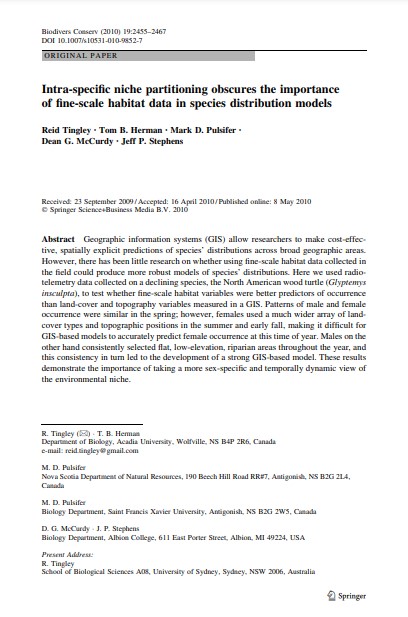Intra-specific niche partitioning obscures the importance of fine-scale habitat data in species distribution models
Bosque Modelo:
Nova Forest Alliance
Temática:
Desarrollo humano
Tipo de documento:
Artículo científico
Resumen
Geographic information systems (GIS) allow researchers to make cost-effective, spatially explicit predictions of species’ distributions across broad geographic areas. However, there has been little research on whether using fine-scale habitat data collected in the field could produce more robust models of species’ distributions. Here we used radiotelemetry data collected on a declining species, the North American wood turtle (Glyptemys insculpta), to test whether fine-scale habitat variables were better predictors of occurrence than land-cover and topography variables measured in a GIS. Patterns of male and female occurrence were similar in the spring; however, females used a much wider array of landcover types and topographic positions in the summer and early fall, making it difficult for GIS-based models to accurately predict female occurrence at this time of year. Males on the other hand consistently selected flat, low-elevation, riparian areas throughout the year, and this consistency in turn led to the development of a strong GIS-based model. These results demonstrate the importance of taking a more sex-specific and temporally dynamic view of the environmental niche.
Información Bibliográfica
Autor:
Tingley, Reid; Herman, Tom B.; Pulsifer, Mark D.; McCurdy, Dean G.; Stephens, Jeff P.
Revista:
BIODIVERSITY AND CONSERVATION
Año:
2010
N°:
9
País :
Canadá
Páginas:
2455 - 2467
Volumen:
19
Idioma:
Ingles
Palabras claves
Distribution GIS Glyptemys insculpta Habitat model Niche partitioning Wood turtle





